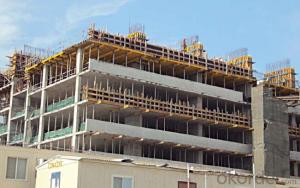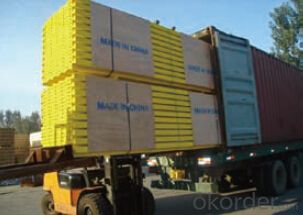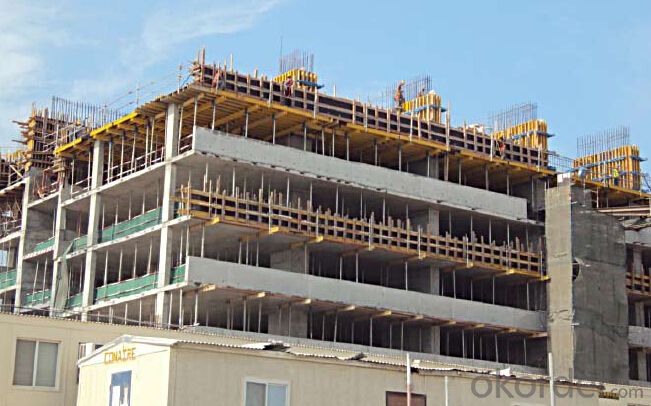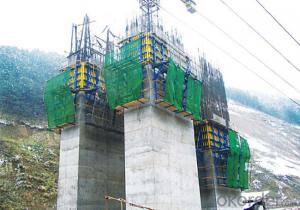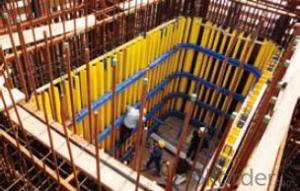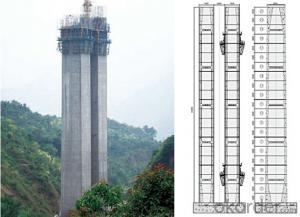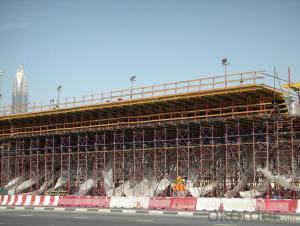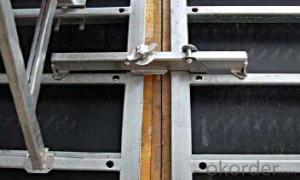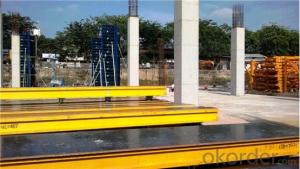Timber-Beam Formwork H20 for formwork and scaffolding system
- Loading Port:
- Tianjin
- Payment Terms:
- TT OR LC
- Min Order Qty:
- 50 m²
- Supply Capability:
- 1000 m²/month
OKorder Service Pledge
OKorder Financial Service
You Might Also Like
Characteristics:
◆ Standardized production lines.
Supply capability: 3000m/day, Lmax = 6600mm.
◆ Finger jointing of the flange and web, the strength of timber beam is highly improved.
Max. shearing force failure load:40KN
◆ Well treated to prevent from water penetration or erosion, so the service life maximally
extended.
Normally, CNBM timber beam H20 can be used for 4 to 5 years, the exact using time would
depend on maintenance & storage.
◆ Robust caps at the end of the girders protect against damages.
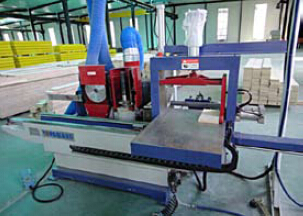
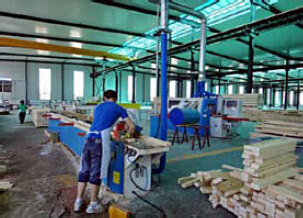
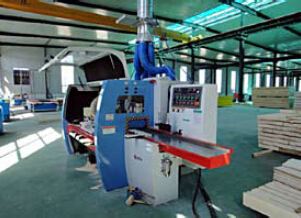
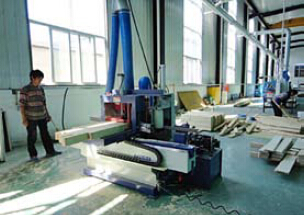
- Q: Can steel formwork be used for precast concrete slabs with openings?
- Yes, steel formwork can be used for precast concrete slabs with openings. Steel formwork is known for its strength and durability, making it suitable for creating complex and intricate designs, including slabs with openings. Steel formwork allows for precise and accurate construction, ensuring that the openings are formed with the desired dimensions and shape. The steel formwork can be easily adjusted and modified to accommodate different sizes and shapes of openings, providing flexibility in design. Additionally, steel formwork can be reused multiple times, making it a cost-effective choice for precast concrete slabs with openings. However, it is important to ensure that the steel formwork is properly engineered and designed to withstand the weight and forces exerted by the concrete and the openings.
- Q: How does steel formwork contribute to the overall sustainability of the project?
- Steel formwork contributes to the overall sustainability of a project in several ways. Firstly, steel is a highly durable material that can withstand heavy loads and repeated use. This means that steel formwork can be used for multiple construction cycles, reducing the need for new formwork materials and minimizing waste. Additionally, steel formwork is highly versatile and can be easily customized to fit various design requirements. This flexibility allows for efficient use of materials and reduces the amount of construction waste generated. Moreover, steel formwork is highly recyclable. At the end of its life cycle, steel formwork can be easily dismantled and recycled, reducing the demand for new steel production and minimizing the environmental impact associated with mining and manufacturing new materials. Furthermore, steel formwork offers better quality control compared to traditional timber formwork. It provides precise and consistent dimensions, resulting in an accurate and high-quality final product. This reduces the need for rework and ensures less material wastage. Lastly, the use of steel formwork can also lead to shorter construction periods. The quick assembly and disassembly of steel formwork allows for faster construction processes, reducing the overall energy consumption and carbon emissions associated with the project. In conclusion, steel formwork contributes to the overall sustainability of a project through its durability, recyclability, versatility, and efficiency. By reducing waste, minimizing environmental impact, and improving construction processes, steel formwork helps create more sustainable and environmentally-friendly construction projects.
- Q: How does steel formwork affect the overall cost-effectiveness of a construction project?
- Steel formwork can greatly enhance the overall cost-effectiveness of a construction project in several ways. Firstly, steel formwork is highly durable and reusable, which means it can withstand multiple uses without any significant wear and tear. This reduces the need for frequent replacements, resulting in cost savings in terms of material expenses. Moreover, steel formwork offers excellent dimensional stability, ensuring accurate and precise construction. This eliminates the need for excessive adjustments and rework, saving both time and money. Additionally, the smooth surface finish provided by steel formwork reduces the need for additional plastering or finishing, further reducing construction costs. Furthermore, steel formwork is known for its high strength and load-bearing capacity. This allows for larger spans and fewer support beams, reducing the amount of material required, and consequently reducing costs. The structural integrity and stability of steel formwork also contribute to a reduction in the number of labor hours required for installation and dismantling, resulting in labor cost savings. In terms of time efficiency, steel formwork offers faster assembly and disassembly compared to traditional formwork systems. This can significantly reduce construction durations, leading to cost savings associated with labor, equipment rental, and overhead expenses. Additionally, steel formwork is highly adaptable and versatile, making it suitable for a wide range of construction projects. Its flexibility allows for customization and adjustments as per project requirements, reducing the need for multiple formwork systems for different construction elements. Overall, the utilization of steel formwork in a construction project can contribute to significant cost savings, thanks to its durability, reusability, dimensional accuracy, reduced finishing requirements, material efficiency, time efficiency, and adaptability. It not only minimizes material and labor costs but also enhances productivity, ultimately resulting in improved cost-effectiveness.
- Q: Can steel formwork be used for underground structures?
- Yes, steel formwork can be used for underground structures. Steel is a durable and strong material that can withstand the pressure and weight of the soil and other forces that act on underground structures. It provides stability and support during the construction process and helps create a solid and robust structure.
- Q: How does steel formwork handle high concrete pressures?
- The exceptional strength and durability of steel formwork make it highly adept at handling high concrete pressures. When faced with significant pressure, steel formwork maintains its shape and structure, serving as a stable and dependable framework for the poured concrete. The strength of steel formwork lies in its capacity to withstand the immense forces generated by the weight and fluidity of the concrete. Steel possesses inherent strength and a high load-bearing ability, enabling it to resist the pressure exerted by the concrete during the pouring and curing process. Furthermore, steel formwork incorporates reinforcement and bracing systems that further enhance its capability to withstand high concrete pressures. Reinforcements, such as steel bars or mesh, are strategically positioned within the formwork structure to provide additional support and prevent any deformation or failure. These reinforcements evenly distribute stress across the formwork, minimizing the risk of damage caused by excessive pressure. Additionally, steel formwork is commonly designed with robust connection points and interlocking mechanisms. These features ensure that the individual components of the formwork system remain securely connected, preventing any collapse or failure under high concrete pressures. The interlocking nature of steel formwork also helps maintain the integrity of the structure and prevents any leakage or seepage of the concrete. In conclusion, steel formwork is specifically engineered to effectively handle high concrete pressures. The intrinsic strength of steel, combined with reinforcement and bracing systems, guarantees that the formwork can withstand the enormous forces exerted by the weight and fluidity of the concrete. Its ability to retain its shape and stability under pressure establishes steel formwork as a reliable and widely chosen option for construction projects that require high concrete pressures.
- Q: How does steel formwork affect the overall construction site productivity?
- Steel formwork can have a significant impact on the overall construction site productivity. Firstly, steel formwork is known for its durability and strength, which allows for multiple reuses on different construction projects. This reusability factor reduces the time and resources required for formwork installation, thereby increasing the productivity of the construction site. Additionally, steel formwork provides better accuracy and precision in shaping concrete structures compared to traditional wooden formwork. The standardized dimensions and design of steel formwork ensure consistent and uniform results, reducing the need for adjustments or corrections during the construction process. This leads to faster and more efficient construction, saving time and improving productivity. Moreover, steel formwork is easy to assemble and disassemble, allowing for quick and efficient formwork installation and removal. This reduces the idle time of workers and equipment, maximizing the utilization of resources and increasing productivity on the construction site. Furthermore, steel formwork offers excellent strength and stability, which allows for higher concrete pouring rates and minimizes the risk of formwork failure. This enables construction teams to work at a faster pace, pouring larger volumes of concrete in a shorter period, and ultimately enhancing overall productivity. Lastly, steel formwork is highly resistant to weather conditions and can withstand harsh environments. This durability ensures that construction activities can continue without interruptions caused by adverse weather conditions, leading to improved site productivity. In conclusion, steel formwork positively impacts construction site productivity by providing durability, reusability, accuracy, ease of assembly, and resistance to weather conditions. These factors contribute to faster construction, reduced downtime, and optimized resource utilization, ultimately enhancing overall productivity on the construction site.
- Q: Can steel formwork be used for water retaining structures?
- Yes, steel formwork can be used for water retaining structures. Steel formwork is known for its strength, durability, and ability to withstand high pressures. When properly designed and constructed, steel formwork can provide a watertight seal and effectively resist the hydrostatic pressure exerted by water. Additionally, steel formwork allows for a smooth and uniform finish, reducing the risk of water leakage. However, it is essential to ensure proper waterproofing measures are in place, such as using appropriate sealing materials and techniques, to prevent any potential water leakage or seepage through joints or connections. Regular inspection and maintenance are also necessary to ensure the long-term integrity of the water retaining structure.
- Q: Can steel formwork be custom-made?
- Yes, steel formwork can be custom-made to suit specific project requirements and dimensions. The flexibility of steel allows for customization in terms of shape, size, and design, making it a popular choice for construction projects that require unique or complex formwork solutions.
- Q: What are the characteristics of steel formwork
- The weight is light, the board width is big, the weight of the combined steel formwork can be reduced by 1/4~1/5, and the width of the template plate can be enlarged, and the joint of the template group is reduced.2, reduce the amount of steel, than the combination of steel templates can be reduced by 1/2.
- Q: How does steel formwork handle architectural features such as openings and recesses?
- Steel formwork proves to be an adaptable construction material capable of effectively managing architectural features like openings and recesses. Its strength and flexibility render it perfect for accommodating these design elements in concrete structures. In terms of openings, such as windows or doors, steel formwork can be easily customized to yield precise and well-defined openings. The formwork panels can be cut or shaped to the preferred size and shape, enabling accurate placement of the concrete around the opening. It also provides stability and support during the pouring and curing process, ensuring the structural soundness of the concrete surrounding the opening. On the other hand, recesses can be effortlessly formed using steel panels specifically engineered to create the desired recessed area. These panels can be shaped or molded to match the architectural design, facilitating a seamless integration of recesses into the concrete structure. Steel formwork allows for meticulous control over the depth and dimensions of the recess, guaranteeing compliance with the design requirements. In addition to its adaptability, steel formwork offers several advantages when dealing with architectural features. Its durability and resistance to deformation enable it to withstand the pressure exerted by the concrete, thereby preserving the formwork's shape throughout the construction process. This is crucial in maintaining the accuracy and integrity of architectural features. Moreover, steel formwork is reusable, making it a cost-effective option for projects involving multiple openings and recesses. The panels can be disassembled, cleaned, and reassembled for future use, reducing the need for new formwork materials and minimizing waste. To summarize, steel formwork is a dependable and efficient choice for managing architectural features like openings and recesses. Its strength, flexibility, and reusability make it an ideal construction material for creating precise and visually appealing architectural designs.
Send your message to us
Timber-Beam Formwork H20 for formwork and scaffolding system
- Loading Port:
- Tianjin
- Payment Terms:
- TT OR LC
- Min Order Qty:
- 50 m²
- Supply Capability:
- 1000 m²/month
OKorder Service Pledge
OKorder Financial Service
Similar products
Hot products
Hot Searches
Related keywords

